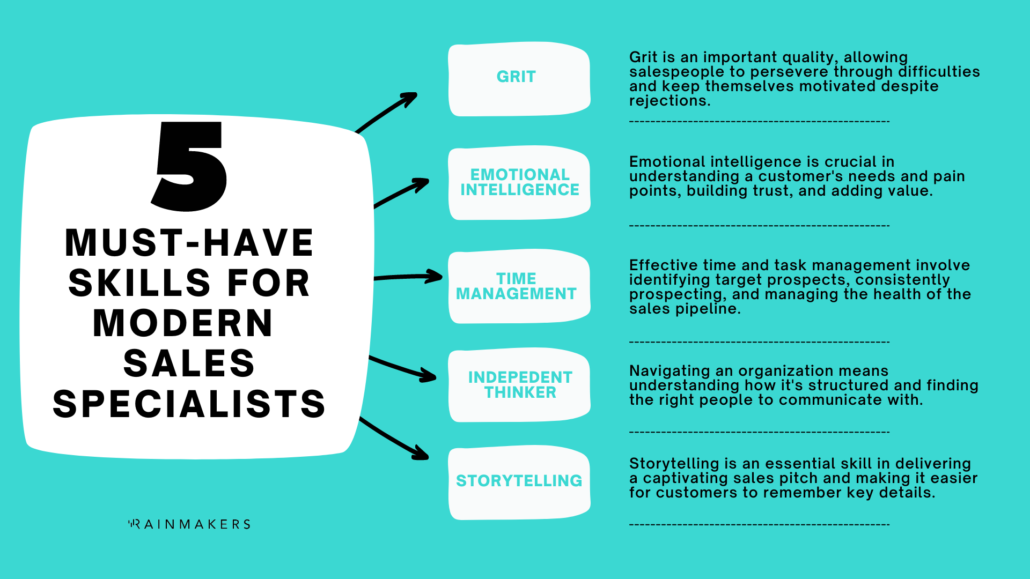Rainmaker Defined
In sales, a rainmaker is known as a person who flourishes in business development and wins new deals at an impeccable rate. Rainmakers are A-Players that typically outperform every person in the organization.
Anyone serious about building their career in sales has thought about or asked, “what is a rainmaker” in sales – and how do I become one? Top performers in sales are equipped for maximum performance in life and business.
They have a range of skills and abilities to understand, form alliances, and challenge and push for the proper outcomes to create success. Those who can make this happen are not only top performers in sales, but they can quickly climb the career ladder.
Establishing The Rainmaker Mindset
People argue about how salespeople are either born or made successful. Is it in their DNA, or are they taught?
I believe it’s actually about your mindset and attitude as a salesperson.
If you speak to prospects as though they are just a stepping stone toward achieving your own goals, you’ll get no cooperation from the prospect. This is why I think it is so important to think very clearly about what sectors and industries you actually care about.
Having this understanding will stop you from trampling over prospects and prospective clients. But if you have invested genuine interest in the sector the prospect is in and work for a company solving their problems, you will act in a way that works toward solving their problems. You’ll think of the prospect before your own needs.
If you care about something, you’ll put in the work, too. Salespeople have the unique ability to put in more work and get more return from it if they do things right. If you care about the niche or sector, you’re helping, what better motivation to put in the extra hour or two after everyone else has already gone home for the day?

Developing The Rainmaker Skills
Let’s breakdown the skills of a Rainmaker into four categories:
- Listening
- Expertise
- Ability to ask great questions
- Control
The emphasis today on personal and professional development has never been higher.
I invest hours – day and night – learning new things.
You don’t have to sit on your laptop and go through an expensive course, but there is so much content available at your disposal.
I listen to sales podcasts instead of music while I work most days, and even when I am taking some time to relax at the weekend, I’ll use my phone podcast app to listen to a few episodes whenever possible.
Make the most of the times when you have silence. For example, when I drive, an audiobook can be played. When at the gym, podcasts or audiobooks can be consumed.
If you have time to read, check out these essential sales books for building a rock-solid foundation in your career.

1) Listening
First and foremost, you must listen to what prospects say. If you don’t hear anything when they talk, how can you tailor your message and solution, let alone the conversation, to help them as best you can? Listen to what is said by a prospect, and understand their problems, reasoning, and goals. What is the need, and why is there a need? If you know the answers to these questions, however essential they may seem, you can at least tailor your response to get into the heart of the problem and solve it. There is nothing less engaging in sales than a generic-sounding, almost scripted salesperson talking.
2) Become An Expert
The natural second part of listening to a prospect is to have a great understanding of the market and the problems they have. Your product/service knowledge must be exemplary. There is no excuse not to have the best knowledge of what you sell on your team – if you haven’t got the best knowledge of it, you operate at a disadvantage.
Nobody wants to speak to a person who can’t help them. You must understand how to direct and guide clients from their current situation toward a successful outcome. This requires a level of skill, knowledge, and experience. If you feel you lack any of those three factors, do whatever you can to build on them. For example, ask to watch how a client is onboarded and serviced if you feel the experience lacks. Or brush up on your product knowledge if you can’t answer tricky questions well.

3) Questions
Asking great questions is an art you need to learn. You must prepare these questions before any call but be able to adapt should things not play out how you think they will. The art of asking great questions revolves mainly around quick but considered thinking.
You must ask a question that extracts the information you need from the prospect and moves them to think about the situation differently so they can see the right path to solving the problem. Get them to see things in a new light. It is much like solving a moving puzzle, but nobody said sales was easy!
Before going into a call, think about this: if the prospect knew the right way to get to the outcome they wanted in every situation, they would have done it already. The salesperson wouldn’t need to add any value or solve any problems. So, think about what the real problem is or what the real solution is. Then, educate and consult on how the prospect and account can reach the outcome. It is your job to have them realize the correct way to get the goal.
4) Control
It is vital to remember in the world of sales today that control is key. You will wait forever for the perfect prospect to stumble into your pipeline who books your following calls for you and asks to have your AE join the next call at the right stage. Sales is like training to be a tennis player. In many ways, the salesperson is the instructor dictating the speed and direction of the rally or the conversation. They adjust what they do according to how the other player works, but ultimately, they are the instructor. The instructor is there to teach the other player and help them break through the walls and steps they need to get through to succeed.
Recap: Becoming A Rainmaker
Of course, this must be done tactfully. For example, there is a level to which you can’t tell your prospect the next call WILL be at a specific time and date, and they WILL bring their VP on the call, etc. It would help if you established the control cleverly by explaining why the VP needs to be on the call, for example. After all, if salespeople had zero control, they would spend all their time talking to lower-level employees who couldn’t implement a change at the senior level.
Are you ready to become a Rainmaker? Start browsing jobs now!















